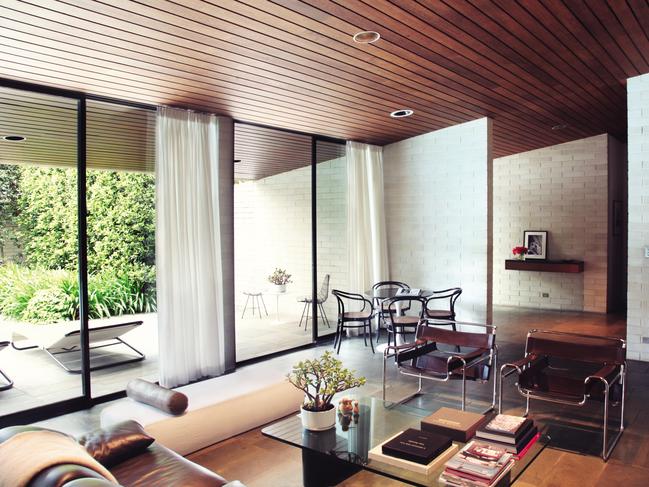Why homes from the ’70s, ’80s and ’90s are the new classics
YOU may have bought an older home to suit your budget but you don’t need to start swinging the sledgehammer just yet

Home Mag
Don't miss out on the headlines from Home Mag. Followed categories will be added to My News.
MISSION brown beams, exposed brick archways and split-level living — these design features get some people running for a sledgehammer, while others want to protect and preserve.
The unique architectural elements of the 1970s, ’80s and ’90s are often viewed with less affection than their Mid-Century counterparts, but homeowners are warming to this unique slice of history.
Retro enthusiast Tim “Rosso” Ross is on a mission to maintain Australia’s mission brown heritage.
“I cry every time someone paints timber beams white,” he says. “Please stop it.”
But he also recognises that some homeowners just have to renovate.
“You should play to the strength of your house,” he says. “If you have a ’70s brick house, please don’t paint or render it. A great ’70s or early ’80s brick house with a bit of mission brown looks fantastic.”
“If you like it and it’s in good condition, keep it,” he says. “Houses aren’t museums but if you dramatically change something in a heartbeat you may live to regret it.”
Rosso says all decades have their own values to be preserved, even the much maligned 1990s.
“I’m having a moment enjoying ’90s kitchens, but most people would rip them out in a heartbeat,” he says.

BEFORE WE BEGIN
Sydney architect Luigi Rosselli, who began his career in the 1980s, says we should “always be obsessed about what came before”.
“In every time period there are good examples, and then there are terrible ones,” he says. “Luckily the terrible ones tend to get lost with time because basically nobody values them,” he says listing the oppressive darkness of the 1970s timber interiors and the fake Georgian and Federation fads of the 1990s as elements best forgotten.
“If I’m working with a 1970s house and we’re trying to save it I’ll keep the best parts, but paint over some of the other surfaces if the timber is too dark,” he says. “There is no respite in some 1970s spaces, they’re very intense. It’s like living in a sitcom.”
And think twice before smashing through that glass brick wall.
“In the ’80s glass blocks were also popular,” Luigi says. “Today everybody says ‘Oh please, no glass blocks!’ I think glass blocks are cool and, give it three years and they will be everywhere.”
If knowing what to ditch and what to keep is too overwhelming, get in a good architect.
“It’s like in a person’s wardrobe, you will find stuff that you should put in the bin and stuff that could be reused,” he says.

SELF PRESERVATION
Marcus Lloyd-Jones of Modern House, a specialist estate agency for architect-designed residences, agrees that these more recent architectural styles are being white washed.
“Please do not render any aged house,” he says. “Mission brown is not a sin!”
Well-preserved examples of these later architectural styles are becoming rarer.
“We already wish there were more good examples of each decade,” Marcus says. “We just need more people to recognise good design so more houses are well-maintained to keep their original design integrity.”
Marcus says any house of architectural merit deserves considered conservation before a renovation, but there are certain design features worth holding on to such as mosaic or cork tiling and exposed timbers of the 1970s. From the 1980s Marcus says Formica kitchen benchtops are great and retro Chroma bathroom fixtures and fittings.
However, he says ‘90s salmon pink as well as the era’s obsession with “faux” Tudor kitchens and fake brass fixtures are unlikely to make a comeback.

THE TOP 10 RENO TIPS TO START
1: Get in an architect early on to help you wade through the good, the bad and the ugly.
2: Think about living in the house for up to a year before getting out the tool belt and jack hammer. You may be surprised just how liveable the home is, even if it’s dated.
3: When reconsidering an older home’s layout think about the future. Open plan might be the way we live now but there is a renewed trend towards “zoned” living.
4: Pinpoint the unique and still functional elements of the home and highlight them.
5: Contemplate toning down the decade, like painting over too dark timber if it’s too much in places, but hold on to some history.
6: Don’t immediately dismiss retro colour schemes and texture for all white walls.
7: Think twice before ripping up period tiles, Terrazzo or slate floors. A resurfacing could add a contemporary touch.
8: If you’re undertaking a big project, try to renovate in stages — room by room or section by section so you’re not living in a complete construction site.
9: Don’t rely on building reports to pick up electrical and plumbing faults from these eras — and always assume that these homes could have hidden faults
10: Allow about 20 per cent more in your budget when working on an older style home for unexpected problems.
